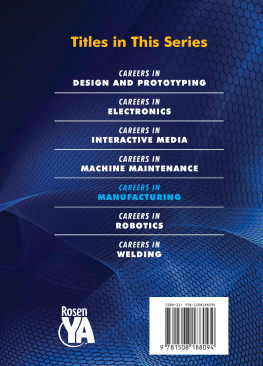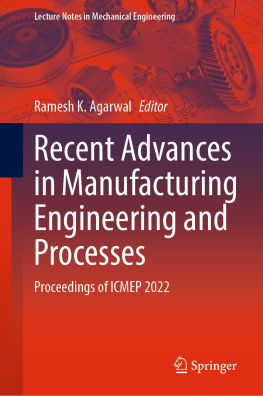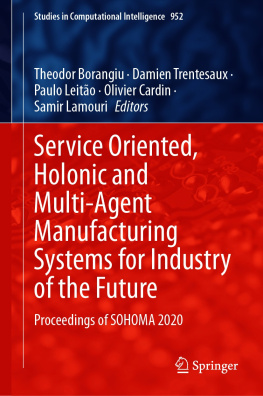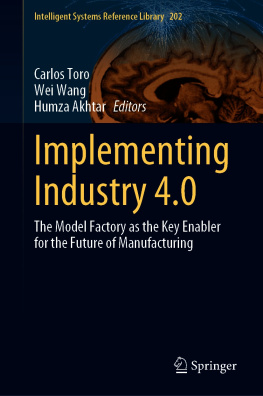
Published in 2020 by The Rosen Publishing Group, Inc.
29 East 21st Street, New York, NY 10010
Copyright 2020 by The Rosen Publishing Group, Inc.
First Edition
All rights reserved. No part of this book may be reproduced in any form without permission in writing from the publisher, except by a reviewer.
Library of Congress Cataloging-in-Publication Data
Names: Shaw, Jessica, 1972 author.
Title: Careers in manufacturing / Jessica Shaw.
Description: First edition. | New York, NY: The Rosen Publishing
Group, Inc., 2020. | Series: Makerspace careers | Includes bibliographical references and index. | Audience: Grades 712.
Identifiers: LCCN 2018048759| ISBN 9781508188100 (library bound) | ISBN 9781508188094 (pbk.)
Subjects: LCSH: Manufacturing industriesVocational guidanceJuvenile literature. | Manufacturing processesJuvenile literature.
Classification: LCC TS183 .S475 2020 | DDC 338.4/767023dc23
LC record available at https://lccn.loc.gov/2018048759
Manufactured in the United States of America
CONTENTS

INTRODUCTION
Manufacturing is defined as making something from raw materials. The first human ancestors to make weapons, jewelry, clothes, and artwork were essentially pioneers of the manufacturing industry. As civilizations have evolved, so have the products being manufactured. Anything and everything that is in demand at any given timethat is, anything that people want or needmust be manufactured by someone. Since there is no foreseeable end to the number or types of products people will want or need, there will most certainly always be a demand for manufacturers. To manufacture is to make, and in one way or another, everyone is a maker, whether or not they sell the products they produce. More than ever before, schools, libraries, businesses, teachers, parents, and communities are encouraging current and future generations of makers, providing spaces specifically designed to inspire and equip people who would like to try their hand at creating. These spaces are commonly referred to as makerspaces and the collective energy and support fueling this transformative phenomenon in communities around the world have come to be known as the maker movement.
Widely regarded as the father of the maker movement, Dale Dougherty has been honored as a White House Champion of Change and recognized as a significant American innovator by President Barack Obama. In 2005, Dougherty launched Make: magazine, which features step-by-step projects, skill-building lessons, and inspirational articles from successful makers. The launch of the magazine was followed by a series of fun maker events around the globe called Maker Faires. Doughertys magazine and Maker Faire events shined a spotlight on the creative spirit of makers and the incredible benefits to makers and to society as a whole when that creative spirit is encouraged and allowed to flourish. In 2009, Obama launched the Educate to Innovate campaign, stating, I want us all to think about new and creative ways to engage young people in science and engineering, whether its science festivals, robotics competitions, fairs that encourage young people to create and build and inventto be makers of things, not just consumers of things. Institutions such as schools, libraries, and museums have answered the call, allocating time, space, and resources for aspiring young creators.

Beginning with the earliest civilizations, people have been innovators and makers, producing everything from weapons, tools, and utensils to pottery, jewelry, and art.
Makerspaces are places where people with shared interests in things like technology, computing, design, engineering, and art can gather to work on projects, either individually or collaboratively, while sharing equipment and knowledge and enjoying the added benefit of bouncing ideas off one another. A makerspace can be as simple as an area for young builders and creators equipped with LEGOs, cardboard, and art supplies or as sophisticated as a workshop equipped with a variety of laser cutters, soldering irons, 3D printers, computer numerical control (CNC) machines, welders, saws, sanders, drills, and sewing machines. For those interested in a career in manufacturing, the hands-on time spent working in a makerspace can be an invaluable experience. The type of equipment found in many makerspaces is similar to equipment commonly used in manufacturing facilities. Before makerspaces, opportunities for people to learn how to use such advanced equipment were limited to advanced coursework in specialized technical courses or on-the-job training. Now, thanks to makerspaces, those eager to land a great job in manufacturing can gain experience in the field before ever setting foot on a jobsite!
CHAPTER ONE
MAKERSPACES: HANDS-ON LEARNING HUBS
T hough no two makerspaces are exactly alike, large-scale makerspaces located in urban areas typically include many types of professional-grade equipment and machinery for makers to use. There are usually membership fees associated with these types of makerspaces, and classes are offered (and sometimes required) to teach members how to use various pieces of equipment. These types of makerspaces are ideal for those interested in careers such as manufacturing, where a working knowledge of many of the same machines will be required. In recent years, many inventors and entrepreneurs have gotten their start on the workroom floor of a makerspace. Whether a makers passion lies in woodworking, programming, auto-motive innovation, or virtually any other hands-on type of tinkering, a makerspace may be the ideal place to learn, grow, and gain an edge in the job market.

Makerspaces are becoming welcome additions to many urban areas around the world, offering creators the space, tools, and resources they need.
CRAFTSMANSHIP 101: WOODWORKING
Woodworking enthusiasts will find a variety of hand tools and power tools to work with in makerspaces. These may include many types of saws such as table saws, compound miter saws, band saws, and scroll saws. CNC wood routers, table routers, and shapers are tools used in makerspaces to hollow out (rout) an area in wood to create a pattern or decorative edge. A mortiser is a specialized wood-working machine used to cut square or rectangular holes in a piece of lumber, whereas a drill press is a machine tool used for drilling standard holes. Another standard piece of woodworking equipment in makerspaces is a lathe. A lathe is a machine tool that rotates a piece of wood while various operations such as cutting, sanding, and drilling are performed with tools that are applied to the wood. Belt or disc sanders are also standard fare in makerspaces and are used to create a smooth, finished wood surface. Makerspace woodworking projects are limited only by a makers imagination. Wooden toys, artwork, and jewelry are a few small-scale projects that can be completed with or without collaboration, while larger projects, including trim work and custom pieces of furniture such as tables, chairs, bookshelves, dressers, cabinets, drawers, and doors are also possibilities in a well-equipped makerspace.













